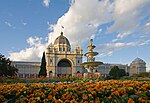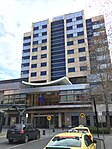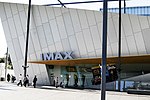Cairo Flats
Heritage-listed buildings in MelbourneUse Australian English from August 2019

Cairo Flats is a heritage-listed apartment building in the Melbourne inner city suburb of Fitzroy. The building was designed in 1935 by architect Acheson Best Overend and built in 1936. It is a U-shaped, two story building comprising 28 apartments, mostly studio flats. Overend was influenced by modernist architect Wells Coates and the "minimum flat concept". Each apartment was designed to "provide maximum amenity in minimum space for minimum rent". The building's cantilevered external concrete stairs was noted as an unusual innovation.
Excerpt from the Wikipedia article Cairo Flats (License: CC BY-SA 3.0, Authors, Images).Cairo Flats
Nicholson Street, Melbourne Fitzroy
Geographical coordinates (GPS) Address External links Nearby Places Show on map
Geographical coordinates (GPS)
| Latitude | Longitude |
|---|---|
| N -37.803 ° | E 144.9746 ° |
Address
Nicholson Street 98
3065 Melbourne, Fitzroy
Victoria, Australia
Open on Google Maps







